The Euro slumped to an 11-day low against the dollar on Monday, January 30, after German inflation data came in slightly weaker than expected.
Having earlier traded lower on concerns over a travel ban implemented by U.S. President Donald Trump, the euro’s fall helped the dollar index – which measures the greenback against a basket of other major currencies – climb half a percent to above 101 for the first time in 10 days .DXY.
The euro, initially stronger on the session, is now down 0.5 per cent to $1.0638 as peripheral bond yields move higher after the IMF warned on the level of Greece’s debt.
The British pound has also relinquished gains, now off 0.4 per cent to $1.2498.The latest figures showed German consumer price inflation hit 1.9 percent in January. While that was the highest in three-and-a-half years, it was slightly below forecasts for a 2 percent annual rise.
A sustained recovery in German inflation would give Bundesbank President and ECB rate-setter Jens Weidmann more scope to argue for winding down the ECB’s bond-buying program more quickly.
“The euro move may be related to the German data, which were a fair bit softer than expected… The euro would normally go up in a risk-off environment,” said RBC Capital Markets currency strategist Adam Cole, in London.
“Dollar/yen is still lower which is consistent with markets being risk-off,” he added, pointing out that currencies usually seen as more risky, like the Australian and New Zealand dollars AUD=D4 NZD=D4, were still down on the day.
A stronger dollar was one of 2017’s big calls for many investment banks and asset managers at the end of last year, but that faith has been undermined by worries about how U.S. trade and diplomacy will pan out under Trump’s presidency.
At the top of the list are concerns that the new administration may actively pursue a weaker dollar as part of efforts to change its trading relationship with China and others.
The dollar had also been weakened by weaker-than-expected U.S. economic growth data on Friday, Reuters reports.














